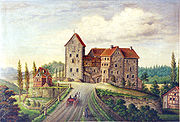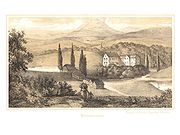
Brennhausen
Encyclopedia
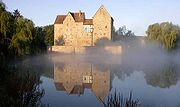
Castle
A castle is a type of fortified structure built in Europe and the Middle East during the Middle Ages by European nobility. Scholars debate the scope of the word castle, but usually consider it to be the private fortified residence of a lord or noble...
in the municipality
Municipalities of Germany
Municipalities are the lowest level of territorial division in Germany. This may be the fourth level of territorial division in Germany, apart from those states which include Regierungsbezirke , where municipalities then become the fifth level.-Overview:With more than 3,400,000 inhabitants, the...
of Sulzdorf a.d.Lederhecke in the district of Rhön-Grabfeld
Rhön-Grabfeld
Rhön-Grabfeld is a district in Bavaria, Germany. It is bounded by the districts of Hassberge, Schweinfurt and Bad Kissingen, and the states of Hesse and Thuringia .-History:In medieval times the region was a part of the Bishopric of Würzburg...
in Bavaria
Bavaria
Bavaria, formally the Free State of Bavaria is a state of Germany, located in the southeast of Germany. With an area of , it is the largest state by area, forming almost 20% of the total land area of Germany...
in Germany
Germany
Germany , officially the Federal Republic of Germany , is a federal parliamentary republic in Europe. The country consists of 16 states while the capital and largest city is Berlin. Germany covers an area of 357,021 km2 and has a largely temperate seasonal climate...
. It is located the Haßberge Nature Park.
Houses of Springs
Josef Braun explains the name Brennhausen in his place-names book as the houses by a water source, meaning, in this case, a spring. Braun bases his statement on the fact that immediately next to the settlement a stream springs forth which flows into the river Saale. Braun discovered that the form Brenn- is a written form, changed from the spoken dialect, which is based on the old form Brünn.Houses of Brunicho
Dr. Heinrich Wagner presents a very different view in his Historischen Atlas von Neustadt/Saale (Historical Atlas of Neustadt/Saale). Wagner believes that the origination of the name had nothing to do with the houses by a water source, but rather that the name of the estate is derived from the old German given name, Brunicho. Under this scenario, the founder of Brennhausen used his own name, as was the custom of that time, for the naming of Brunechenhusen.1182 Officially documented
The first known mention of Brennhausen in an official document was the year 1182. In this document, Graf Poppo von Henneberg, (VI?) leased to his faithful Wolfram, among others, a tenth of Brunechenhusen.On August 29, 1237, Graf Poppo von Henneberg, VII declared that his vassals "Deynodapifer and Theodericus, so-called von Blanckenberg," must repair the damage done to the Brunechenhusen property when it was unjustly withheld from the abbot and the Bildhausen convent.
Truchseß von Brennhausen
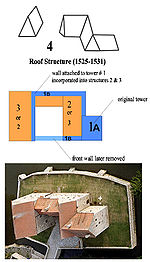
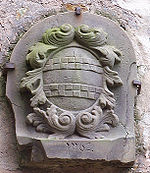
In another record book of the Prince-Bishop Albrecht von Hohenlohe, used from 1345–1372, it was written in 1345: “Johannes Truchseß von Alsleben owns also a tenth of Gabolshausen, a tenth of Poppenhausen, a half-tenth of Ermershausen
Ermershausen
Ermershausen is a municipality in the district of Haßberge in Bavaria in Germany.-Sons and Daughters of the Village:* Louis Kissinger , father of Henry Kissinger...
, a tenth of Brennhausen, and a half-tenth of Maroldsweisach
Maroldsweisach
Maroldsweisach is a municipality in the district of Haßberge in Bavaria in Germany.-Local Citizens of Note:* Joseph Brunner was born in Trappstadt and died in Altenstein...
.”
In 1343, Hans Truchseß was mentioned in a directory of Wetzhausen. It was written: “Notation regarding Mr. Hansen Truchseß, soul of a knight of Brünnhausen and his wedded wife. Owned Wetzhausen, Brünnhausen, Eßfeld and part of zu Sternberg.” His four Sons inherited these four places after his death and started four independent lines which later branched out even more. Diez, the actual founder of the Wetzhausen line, was given by his father, Hans, all of Wetzhausen and one third of Brennhausen.
Hans Truchseß the Younger (1309–1370) received two thirds of the Brennhausen holdings and part of Sternberg. Hanns had his residence in Brennhausen.
Brennhausen remained in the Truchseß family until 1542 when Georg Truchseß died with a brief intermission around 1500. Anna, daughter of Philipp Truchseß took Brennhausen into a marriage with Hans von Berlichingen, a vassal of Wilhelm Count von Henneberg
Henneberg
Henneberg may refer to:*the House of Henneberg, German nobility*County of Henneberg, a mediæval state in the Holy Roman Empire*Henneberg, Thuringia, a municipality in Thuringia, Germany*Mary Jane Henneberg, b. 1973, TV reporter...
. After Hans von Berlichingen death, Anna sold Brennhausen to pay her husband’s debts and Brennhausen ended up with Dietz Truchseß.
Bauernkrieg and the Burning of Brennhausen
Both documentation and physical evidence strongly suggest that Brennhausen burned in 1525 during the Bauernkrieg or Peasants (or Farmers) Revolt. The beams of the roof and the entrance to one of the cellars date from right after 1525. Stone work also suggests that the floor levels changed at some point. Also G.P. Höhn in his 1747 Lexicon Topographicum states that the peasants set fire to it in 1525.1542-1681
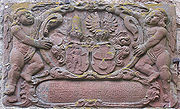
Kotzau
The House of Kotzau was a local noble family in Franconia.The House of Kotzau took its name from the village of Kotzau, today called Oberkotzau and it is located in the district Hof in Upper Franconia. Famous members of the family were abbess in the abbeys of Himmelkron and Hof. Hans von Kotzau...
. By 1593, the Truchseß family were back at Brennhausen. In 1619, the brothers Otto, Heinrich and Adam von und zu Bastheim along with Georg Wilhelm and Veit Ulrich Truchseß von Wetzhausen purchased Brennhausen for 24,597 gulden.
Franz and Hans von Brennhausen
In 1642, a Franz Günther, a simple farmer's son from KützbergPoppenhausen
Poppenhausen is a municipality in the district of Schweinfurt in Bavaria, Germany.It consists of the following six localities: Hain, Kronungen, Kützberg, Maibach, Pfersdorf, Poppenhausen....
by Schweinfurt
Schweinfurt
Schweinfurt is a city in the Lower Franconia region of Bavaria in Germany on the right bank of the canalized Main, which is here spanned by several bridges, 27 km northeast of Würzburg.- History :...
, was ennobled “von Brennhausen” and given the fief of Brennhausen from the Bishopric of Würzburg
Bishopric of Würzburg
The Bishopric of Würzburg was a prince-bishopric in the Holy Roman Empire, located in Lower Franconia, around the city of Würzburg, Germany. Würzburg was a diocese from 743. In the 18th century, its bishop was often also Bishop of Bamberg...
. From 1635 to 1647, Franz was the Commandant of the fortress at Königshofen. Franz’ son Hans received Brennhausen and died without issue. Franz and his wife Felicitas Agnes Leschin von Mülheim coat of arms are in the court yard.

Brennhausen Goes to Bibra Family
In 1681, the von Bibra family received Brennhausen instead of BurgwallbachSchönau an der Brend
Schönau an der Brend is a municipality with 1378 inhabitants in the district of Rhön-Grabfeld in northern Bavaria, Germany. It consists of two villages: Schönau an der Brend and Burgwallbach.-Points of interest:* Gyrowheel Monument...
as part of an out of court settlement of a lawsuit dating from 1602 when the Prince Bishop Julius Echter von Mespelbrunn
Julius Echter von Mespelbrunn
Julius Echter von Mespelbrunn was a Prince-Bishop of Würzburg, Echter was born in Mespelbrunn Castle, Spessart and died in Würzburg....
refused to transfer family fiefs between cousins. This type of transfer was routine but during the Counter Reformation, the bishop refused a transfer to the Protestant cousins. Brennhausen has remained with the Bibra family ever since.
